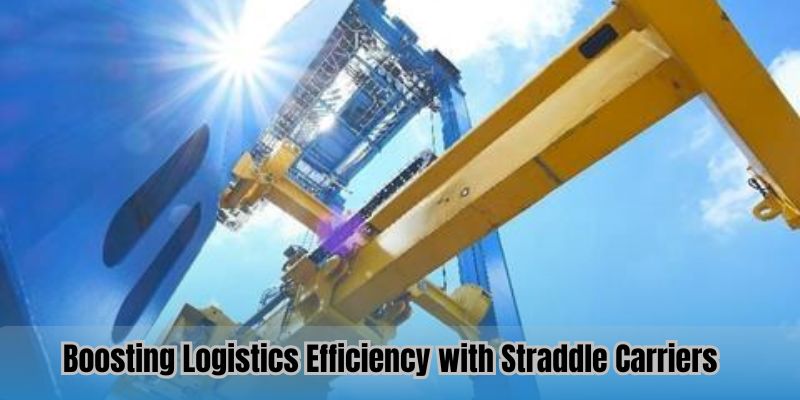Efficiency, in the modern sense of logistics and transportation, serves as a backbone for prosperity in this industry. That is because it’s only able to rapidly, safely, and affordably move goods against a backdrop of global demand that these supply chains create and operate on. Among innovations for this purpose, straddle carriers stand out as excellent machinery for significantly improving handling and transporting cargo, such as in port and terminal operations. With flexibility, precision, and high performance, the straddle carriers have become essentials in optimizing logistic efficiency.
Specialized Vehicles for Efficient Cargo Handling
Specialized vehicles for short-distance lifting and transportation of heavy cargoes are very important elements in streamlining operations in a port, intermodal terminal, or industrial storage facility. These machines can lift straight from the ground, off trucks, or railcars and stack containers efficiently; they do not require additional handling equipment. Their precision makes them invaluable in spaceconstrained environments like busy container yards. They link one stage to another in the logistics process for an uninterrupted transition from arrival of cargoes to storage to sending.
Space Optimization and Flexibility
One of the advantages of these machines is that they optimize space in operations. Traditional cargo handling methods require expansive area for maneuvering and also for storage, which renders them inefficient. These machines on the other hand are highly designed to navigate narrow aisles as well as tight spaces. Their designs allow them to transport and stack containers without interfering with other activities.
This space efficiency is particularly advantageous in high-density areas such as ports and urban logistics hubs. These vehicles minimize the footprint needed for container handling, thus enabling facilities to maximize storage capacity, which results in huge cost savings and better utilization of available resources.
Enhancing Operational Efficiency
These machines are designed to quickly and efficiently lift heavy loads, thereby greatly improving the efficiency of operations. They have the ability to lift and move containers in one motion, cutting down on handling stages and saving both time and labor. Additionally, they can load containers directly from the chassis of a truck or rail car, cutting intermediary steps in the logistics chain.
These vehicles minimize the risk of damaging goods due to precise handling. Advanced control systems also increase their reliability, allowing operators to handle cargo with increased precision and safety. Features such as load balancing and weight monitoring contribute to smoother operations, reducing human error and ensuring consistent performance.
Reducing Turnaround Times
Efficiency in cargo movement is very important for maintaining schedules and saving costs in logistics. These machines play a very significant role in reducing turnaround times of trucks, ships, and trains through faster loading, unloading, and stacking. This ability is crucial in ports where rapid turnaround of vessels is necessary.
Unlike traditional equipment that often requires coordination with additional machinery, these vehicles operate autonomously, enhancing workflow efficiency. Their independent functionality eliminates bottlenecks and accelerates cargo handling processes, making them indispensable in high-pressure logistics environments.
Improved Safety Standards
Safety is a top concern in any logistics operation, especially when dealing with heavy cargo. These machines incorporate features that prioritize worker safety and cargo integrity. Elevated cabins offer operators an unobstructed view of their surroundings, enhancing situational awareness.
Modern models are advanced and have sophisticated safety technologies that include collision avoidance systems, automatic braking, and much more. These features have helped to reduce risks such as operator error or unexpected obstacles in the working environment, hence making the operations much safer and reliable.
Environmental Benefits
Sustainability is becoming the talk of the town in logistics, and energy-efficient designs contribute to reducing environmental impact. Most of the modern models use eco-friendly engines or electric power, thereby lowering greenhouse gas emissions and fuel consumption.
Electric-powered versions produce no emissions while in use and are even quieter, perfect for urban use or areas that have stringent regulations on emissions. In addition, by embracing such fuel-efficient technologies, logistics facilities would be able to achieve sustainability targets while remaining productive, thus enhancing the reputation of a business that is environmentally responsible.
Adaptability Across Industries
The versatility of these vehicles extends beyond port operations, making them valuable across various industries. In manufacturing, they facilitate the movement of raw materials and finished products within production facilities. In retail and distribution, they enable efficient transfer of goods between warehouses and transportation networks.
Their adaptability has been such that businesses use them for specific needs, which include handling bulk cargo, specialized containers, or oversized loads. With this flexibility, they turn out to be an essential solution to diverse logistical challenges and address many operational requirements.
The Future of Cargo Handling Technology
As logistics evolve, so does the technology attached to these vehicles. Automation, artificial intelligence, and advanced telematics are changing their abilities, and fully automated models have already been deployed in some facilities that promise unprecedented efficiency and accuracy.
Autonomous functionality removes the need for direct human intervention, thereby reducing labor costs and minimizing errors. Telematics integration allows for remote monitoring and management, thus optimizing performance and maintenance. All these advancements promise to further improve productivity, safety, and sustainability in the logistics sector.
Conclusion
Specialized cargo-handling vehicles, like Container Lifting Machine are an indispensable part of the logistics industry. They deliver unmatched efficiency, safety, and adaptability in logistics, thereby fulfilling the complex demands of modern logistics. By optimizing space usage, reducing turnaround times, and enhancing operational performance, they align with sustainability objectives and technological advancement potential to remain a crucial component of the future of global supply chains. Investments in such versatile machines enable the business to make the best out of a dynamic and competitive logistics landscape, thus preparing it for the long term.







